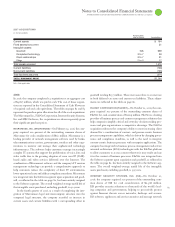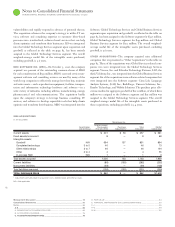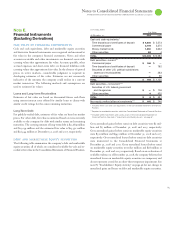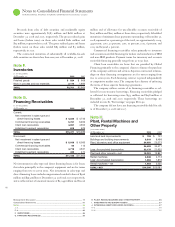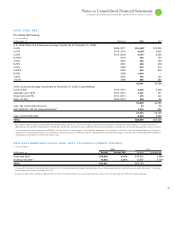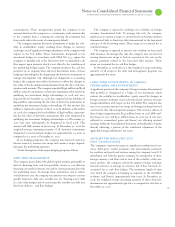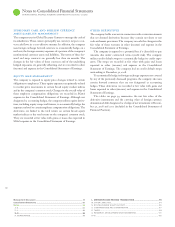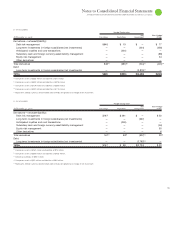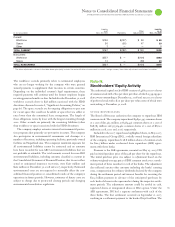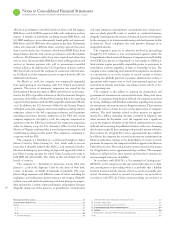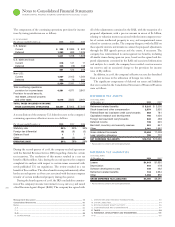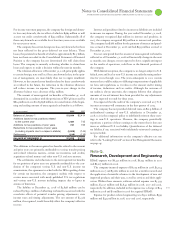IBM 2008 Annual Report Download - page 93
Download and view the complete annual report
Please find page 93 of the 2008 IBM annual report below. You can navigate through the pages in the report by either clicking on the pages listed below, or by using the keyword search tool below to find specific information within the annual report.
Notes to Consolidated Financial Statements
INTERNATIONAL BUSINESS MACHINES CORPORATION and Subsidiary Companies
counterparties. These arrangements permit the company to net
amounts due from the company to a counterparty with amounts due
to the company from a counterparty reducing the maximum loss
from credit risk in the event of counterparty default.
The company employs derivative instruments to hedge the vola-
tility in stockholders’ equity resulting from changes in currency
exchange rates of significant foreign subsidiaries of the company with
respect to the U.S. dollar. These instruments, designated as net
investment hedges in accordance with SFAS No. , expose the
company to liquidity risk as the derivatives have an immediate cash
flow impact upon maturity which is not offset by the translation of
the underlying hedged equity. The company monitors the cash loss
potential on an ongoing basis and may discontinue some of these
hedging relationships by de-designating the derivative instrument to
manage this liquidity risk. Although not designated as accounting
hedges, the company may utilize derivatives to offset the changes in
fair value of the de-designated instruments from the date of de-des-
ignation until maturity. The company expended $ million and $
million related to maturities of derivative instruments that existed in
qualifying net investment hedge relationships in and ,
respectively. At December , , the company had net liabilities of
$ million, representing the fair value of derivative instruments in
qualifying net investment hedge relationships. Of this amount, $
million is expected to mature in fiscal . In addition, at December
, , the company had net liabilities of $ million, represent-
ing the fair value of derivative instruments that were designated in
qualifying net investment hedging relationships as of December ,
, but were subsequently de-designated in fiscal . This
amount will fully mature in fiscal . At December , the
weighted-average remaining maturity of all derivative instruments
designated as net
investment hedges was approximately . years as
compared to . years
at December , .
In its hedging programs, the company uses forward contracts,
futures contracts, interest-rate swaps and currency swaps, depend-
ing upon the underlying exposure.
A brief description of the major hedging programs follows.
The company issues debt in the global capital markets, principally to
fund its financing lease and loan portfolio. Access to cost-effective
financing can result in interest rate and/or currency mismatches with
the underlying assets. To manage these mismatches and to reduce
overall interest cost, the company uses interest-rate swaps to convert
specific fixed-rate debt into variable-rate (or “floating-rate”) debt
(i.e., fair value hedges) and to convert specific variable-rate debt into
fixed-rate debt (i.e., cash flow hedges).
The company is exposed to exchange rate volatility on foreign
currency denominated debt. To manage this risk, the company
employs cross-currency swaps to convert fixed-rate foreign currency
denominated debt to fixed-rate debt denominated in the functional
currency of the borrowing entity. These swaps are accounted for as
cash flow hedges.
The company is exposed to interest rate volatility on forecasted
debt issuances. To manage this risk, the company may use forward
starting interest-rate swaps to lock in a portion of the rate on the
interest payments related to the forecasted debt issuance. These
swaps are accounted for as cash flow hedges.
At December , and , the weighted-average remaining
maturity of all swaps in the debt risk management program was
approximately five years.
-
( )
A significant portion of the company’s foreign currency denominated
debt portfolio is designated as a hedge of net investment which
reduces the volatility in stockholders’ equity caused by changes in
foreign currency exchange rates in the functional currency of major
foreign subsidiaries with respect to the U.S. dollar. The company also
uses cross-currency interest rate swaps and foreign exchange forward
contracts for this risk management purpose. The currency effects of
these hedges (approximately $ million losses in , $ mil-
lion losses in and $ million losses in , net of tax) were
reflected in accumulated gains and
(l
osses) not affecting retained
earnings within the Consolidated Statement of Stockholders’ Equity,
thereby offsetting a portion of the translation adjustment of the
applicable foreign subsidiaries’ net assets.
The company’s operations generate significant nonfunctional cur-
rency, third-party vendor payments and intercompany payments
for royalties and goods and services among the company’s non-U.S.
subsidiaries and with the parent company. In anticipation of these
foreign currency cash flows and in view of the volatility of the cur-
rency markets, the company selectively employs foreign exchange
forward contracts to manage its currency risk. These forwards are
accounted for as cash flow hedges. The maximum length of time
over which the company is hedging its exposure to the variability
in future cash flows is approximately four years. At December ,
, the weighted-average remaining maturity of these derivative
instruments was approximately days as compared to days at
December , .


